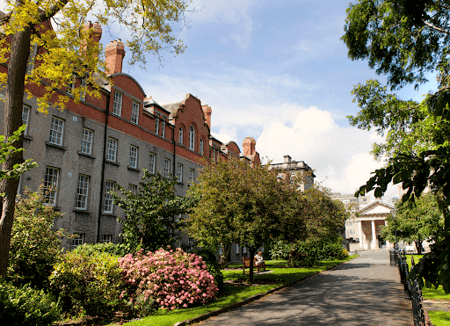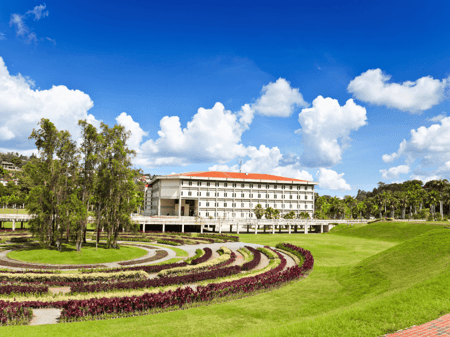
Home / Here on Earth / Beyond Education: Growing Student Enrollment & Experience
Landscape and environment play a crucial part in the development of encouraging young minds, especially for students in an educational school whether it be preschool, elementary school, middle school, high school, university, or any specialty school. While the green environment and the surroundings positively influence the health of children and adults, it is also the foundation for prosperity in the near future.
Optimal conservation and rehabilitation of existing natural landscapes is important, not just to reflect diversity but to encourage the students with creative thinking while stimulating their attitude toward nature which impacts their health as well.
The Social And Environmental Behavior
 It is no secret that students go through a great deal of stress when it comes to their school life, including assignments and peer pressure. This stress leads students to poor academic performance. At the same time, research and studies have shown that stress can be reduced through the landscape and natural views around students.
It is no secret that students go through a great deal of stress when it comes to their school life, including assignments and peer pressure. This stress leads students to poor academic performance. At the same time, research and studies have shown that stress can be reduced through the landscape and natural views around students.
Researchers state that the existence and presence of landscapes, which includes water features, landmarks, structures, and other landscape elements, assist in providing a better quality of life to students or staff with a better, healthy, and sustainable environment.
Some of the main factors that affect a student's educational performance have been found to be:
- The background and socio-economic status of the students.
- School size.
- Size of the class.
- Teachers' way of teaching.
- Lighting and noise.
- Building age and its surroundings.
As you can see, many of these factors may be outside of a school district's control, however, creating and ensuring students have an outdoor landscape to breathe in fresh air, decompress, and interact with nature is a factor that is within the school's control. The benefits of contact with the environment and surrounding nature are given below.
Behavior benefits - Researchers have found that outdoor areas made for students help in increasing social interaction and creative thinking among young minds that affect self-development.
Health benefits - Studies reflect that the touch of vegetation, the presence of green landscape, water features, and natural elements help in relieving stress and increase performance which can be easily understood by ART (Attention Restoration Theory) that includes landscape theories which also confirm attention restoration.
What Can Campus Landscapes Provide?
Sustainability Catalysts
From the environmental perspective, the right balance between the utilization of resources and their performance is critical. Landscaping cannot be done just to attract parents; and it is done to contribute something to nature. For instance, storm water runoff can be reduced by sports fields. Also, refrain from assuming that a landscape cannot support sustainable features only because it's historic. It's important to note that soil and healthy plants are one of the most essential, cost-efficient and effective ways of seizing and sequestering carbon.
Technology Integrator
It has been observed that campus landscapes are embracing the technological environment and contributing to new developments and innovations. Today, campuses are looking into curb management strategies and wondering if the present needs comply with the drop-off zones when it comes to transportation. And now, new development is being noticed regarding autonomous vehicles, which can pretty much alter transportation in the coming years. Since technology is playing a major part in campus landscape and significant real estate can be used for parking, it is effective if all of these are accounted for in-campus design efforts.
Wellness Space
When it comes to wellness, anxiety, depression, sleep difficulties, and stress affects academic performance. But again, the landscape can help in boosting that academic performance while improving anxiety or depression, among others. Consider including intimate settings for getting together or studying or smaller, relatively quiet places for students to enjoy their leisure time.
Network & Socialize
Observing your landscape work in real-time depicts the use of technology and new approaches not just during the planning process but also during the maintenance period. This level of use of data to efficiently facilitate parking management and security, among other operations, adds to productivity and collaborative culture.
Landscapes in campuses or educational institutes represent the connectivity among students, nature, community resources, wellness, technology, behavior, etc. Landscape plays a key role in navigating its relationship with humans, which is ever-changing but achieving the holistic campus view with the integrated planning process is worth the effort.
Competitive Edge
Today, when schools, colleges, and universities market their campus more than anything, it is vital to understand that there is a competitive market of education out there; and it's pretty challenging to beat them. Hence, let's know at least the basics to get a grasp on the ideas that can lead to motivated students and enhanced learning abilities.

What's Your Landscaping Plan?
To start with landscaping planning, one must have a design in hand. And for a good design, the right research is required. Apart from planning for a new landscape for college landscapes or schoolyards, one can simply opt to update the landscape according to their needs.
Educational institutes must as well consider the factors that affect the planning for landscaping majorly, such as availability of workers, infrastructure, cost, etc. Keeping the maintenance and longevity of these infrastructures and impactful designs in mind is equally important.
Keep in mind that the construction takes place only once, which is why upkeep is essential since it determines the longevity and is cost-effective rather than repair costs. Here are some ideas for your landscape plan:
- Consider adding greenery to the landscape, not just for curb appeal, but increasing vegetation which helps in reducing noise and creating fresher and cleaner air through the process of photosynthesis.
- Also, try creating an all-year-round appeal by including seasonal plants such as daisies for summer, maple trees for the fall, or oakleaf hydrangea for multiple seasons.
- Consider safety through maintaining hardscapes, trimming bushes, shrubs, and trees, installing perimeter lines, and using landscape lights.
- Improve the walkways through permeable pavers and encouraging students to walk and bike can be a great move towards reflecting the school's care of the students, staff, and visitors' safety.
- Install shade structures for relaxing spots or multi-purpose spots where students can host gatherings.
- Outdoor amenities, like trash and recycling bins, should be placed to promote cleanliness.
- Outdoor spaces that are multi-purpose.
- Create a lovely landscape to triumph "the first impression is the last impression."
- Add colors to the landscape for the students to always feel fresh and excited.
- Universities that come with landscaping and horticulture programs should consider including varied trees and shrubs in their landscape.
- Educational institutes can try creating rain gardens or culinary gardens to stand out.
Contact experienced landscapers and landscape designers by reaching out to us. Visit Down To Earth Landscape & Irrigation for more information.
